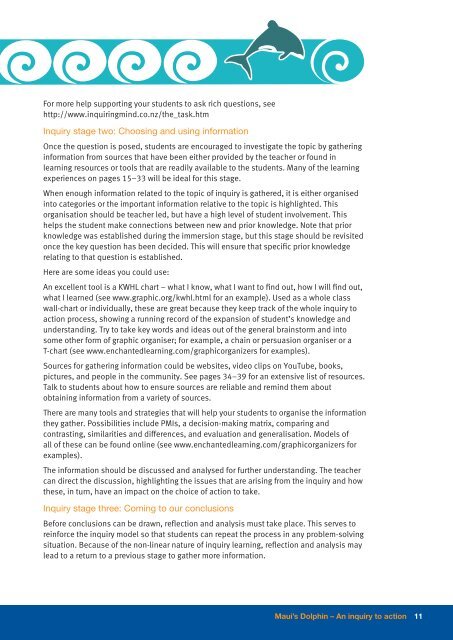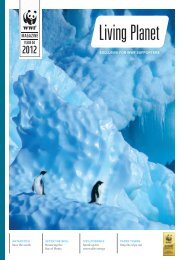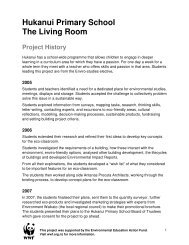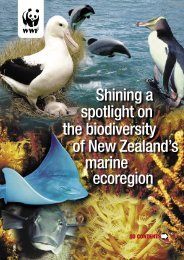Maui’s Dolphin –
Maui's Dolphin â - Panda - WWF
Maui's Dolphin â - Panda - WWF
- No tags were found...
Create successful ePaper yourself
Turn your PDF publications into a flip-book with our unique Google optimized e-Paper software.
For more help supporting your students to ask rich questions, see<br />
http://www.inquiringmind.co.nz/the_task.htm<br />
Inquiry stage two: Choosing and using information<br />
Once the question is posed, students are encouraged to investigate the topic by gathering<br />
information from sources that have been either provided by the teacher or found in<br />
learning resources or tools that are readily available to the students. Many of the learning<br />
experiences on pages 15<strong>–</strong>33 will be ideal for this stage.<br />
When enough information related to the topic of inquiry is gathered, it is either organised<br />
into categories or the important information relative to the topic is highlighted. This<br />
organisation should be teacher led, but have a high level of student involvement. This<br />
helps the student make connections between new and prior knowledge. Note that prior<br />
knowledge was established during the immersion stage, but this stage should be revisited<br />
once the key question has been decided. This will ensure that specific prior knowledge<br />
relating to that question is established.<br />
Here are some ideas you could use:<br />
An excellent tool is a KWHL chart <strong>–</strong> what I know, what I want to find out, how I will find out,<br />
what I learned (see www.graphic.org/kwhl.html for an example). Used as a whole class<br />
wall-chart or individually, these are great because they keep track of the whole inquiry to<br />
action process, showing a running record of the expansion of student’s knowledge and<br />
understanding. Try to take key words and ideas out of the general brainstorm and into<br />
some other form of graphic organiser; for example, a chain or persuasion organiser or a<br />
T-chart (see www.enchantedlearning.com/graphicorganizers for examples).<br />
Sources for gathering information could be websites, video clips on YouTube, books,<br />
pictures, and people in the community. See pages 34<strong>–</strong>39 for an extensive list of resources.<br />
Talk to students about how to ensure sources are reliable and remind them about<br />
obtaining information from a variety of sources.<br />
There are many tools and strategies that will help your students to organise the information<br />
they gather. Possibilities include PMIs, a decision-making matrix, comparing and<br />
contrasting, similarities and differences, and evaluation and generalisation. Models of<br />
all of these can be found online (see www.enchantedlearning.com/graphicorganizers for<br />
examples).<br />
The information should be discussed and analysed for further understanding. The teacher<br />
can direct the discussion, highlighting the issues that are arising from the inquiry and how<br />
these, in turn, have an impact on the choice of action to take.<br />
Inquiry stage three: Coming to our conclusions<br />
Before conclusions can be drawn, reflection and analysis must take place. This serves to<br />
reinforce the inquiry model so that students can repeat the process in any problem-solving<br />
situation. Because of the non-linear nature of inquiry learning, reflection and analysis may<br />
lead to a return to a previous stage to gather more information.<br />
<strong>Maui’s</strong> <strong>Dolphin</strong> <strong>–</strong> An inquiry to action<br />
11






